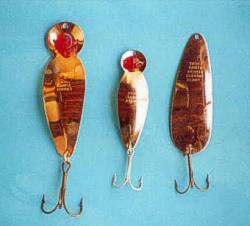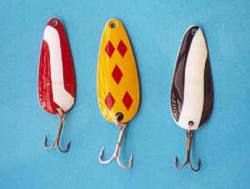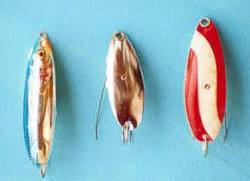Spoon Fed Pike
By Tim Shamess
It seems that more and more emphasis is being put on
the use of body baits. Tackle companies are spending more money developing the perfect
swimming action, the perfect wobble, or rattle, or any number of other characteristics.
The spoon seems to have fallen by the wayside in favour of Husky Jerks, Bombers,
Torpedoes, and other similiar lures.
However, one cannot belittle the fact spoons have, and
will continue to, catch big pike. A recent tournament drove the point home to me in a big
way. It was the last hour of the tournament, we were down four pike. The fishing had been
slow at best, not a cloud in the sky, no wind, very hot. My partner and I had been
throwing everything, including the kitchen sink. I put on a blue and silver Little Cleo
and with a slow retrieve, the four pike we needed couldn't resist the flash and thumping
wobble of the spoon. We went from placing in the high seventies, to the top twenty.
Now, as I sit here watching the ice melt, my thoughts
are on early season pike. If you're like me, there's nothing like quietly sneaking into a
backwater bay, seeing the shadow flash toward your lure, the smash of the strike, and the
dash for freedom a big pike makes when hooked. We should backtrack a little here and look
at what brings us to this point.
Just after the ice begins to break up, female pike
begin to move into shallow, weedy bays. When the water temperature reaches the 40 to 45
degree range, large females, often accompanied by one or more smaller males, will deposit
her eggs in six inches to three feet of water. Pike do not build a nest, the eggs are
randomly dropped and will stick to vegetation. The water closer to shore usually warms up
first so the eggs are usually dropped close to shore. A few days after spawning, the
females leave the area. The males will stay in the area for several weeks but do not
protect the eggs or the fry. The eggs and fry are preyed upon by crayfish, insects , birds
and other fish.
There are a few things I always look for when I am
looking for early season pike, no matter where the lake or waterway is located. The best
spawning areas will have access to deeper water close by because, as I said, a few days
after spawning, the females will leave the spawning area for deeper water. The deeper
water also provides an escape for the pike should some threat arise. This may only
be a depth of eight to 12 feet. I like a backwater bay that is close to a main lake; a bay
far from a main lake will rarely have the numbers of fish a closer bay would hold. After
they spawn, pike will head to the first deep drop-off they find, and will feed on whatever
they can. They will stay here until the water warms even more.
A stream, or river inlet, will provide both high oxygen
content and food for the pike. Pike will not stray far from food and generally the area
near the shore will be most fertile. I have caught more big pike where a stream enters a
larger body of water than anywhere else.
Pike feed by ambushing their prey and therefore need
cover to hide behind, so the back bay needs lots of weeds. The eggs will stick to the
weeds as well. Smaller baitfish and other food will be found trying to hide from foragging
pike by hiding in the same weeds . I try to keep an eye out for fish, or other prey, the
pike will be feeding on.
I always watch where the sun is shining the strongest.
Exposure to sunlight will allow the bay to warm faster, and the warmer bay will have more
weed growth, creating good conditions for the pike to begin spawning. At the same time,
keep in mind that the sun will be casting your shadow, which can spook that trophy sunning
in the shallow water.
The most common way to fish with spoons is to cast and
retrieve , or troll at a steady pace. A stop-and-go retrieve has proved productive for me,
this lets the spoon drop and flutter. Often the fish will strike when the lure drops, so I
prefer to use the drop-and-flutter instead of the Figure Eight when I have a follow.
I have more strikes doing this, than with the Figure Eight. At a deeper drop-off, I have
had luck jigging a spoon up and down, where, again the strike occurs on the downward
flutter. To keep the action of a spoon as natural as possible I will use a shorter leader,
in the area of three to four inches, a steel leader is a must to land a toothy pike.
While spoon baits are very basic in design, I have some
favourites. The Toronto Wobbler, made by Lucky Strike, is my main spoon,
I'll use this more then any other. The combination of gold and silver provides plenty of
flash, not to mention the solid feel when casting this lure. This spoon is a good
general-purpose spoon and if I'm in a lake I've never fished before, I like to use this
one.

From Lucky Strike, a gold Scarlett Eye, a silver Scarlett eye and a
Toronto Wobbler.
Also made by Lucky Strike is the Scarlet Eye. The thin
body of this lure makes it a good choice if there is thick weed cover. I find it will rip
through weeds easily. The red eye gives a different type of look as the lure spins ; it
reminds me (and, I'm sure the pike) of a wounded baitfish.
Two classic spoons, whose reputation speaks for
themselves are the Daredevle and the Five of Diamonds. I haven't met a fisherman yet who
doesn't have at least one Daredevle (or a knock off) in their tackle box. It seems like
the old devil has been around forever. I'm willing to bet there have been more fish caught
on Daredevle's then any other lure. The red-and-white combination is like a red flag to a
bull. I often think that a pike will strike just because the spoon is driving him mad! I
have several; some with a silver back, while others have a gold back. I find the gold
gives a little extra flash in murky water.

The classics, red-and-white Daredevil, Five of Diamonds, and a black and
white Daredevil.
The Five of Diamonds is a spoon that I never liked the
looks of until two pike over 40 inches changed my mind. It was at the mouth of a river
emptying into a deep, rocky bay, I threw the Five of Diamonds and reeled it in fast; a
short follow became a strike with a short pause in reeling. This is another lure I like,
if I'm on an unfamiliar lake.
I also keep a few weedless spoons in my box just in case I'm
in a very weedy bay. Rapala has recently brought out a line of weedless spoons; these have
a thick, solid body with a deep curve . The action is good and these spoons are coloured
to look like baitfish . I've used them with a twister-type tail to give an added action ;
pike seem to like this little extra action.

The weedless lures I
use, a blue and silver Rapala, Johnson Silver Minnow, Johnson Daredevil.
I also have a couple Johnson Silver Minnows in my
weedless arsenal too. These, while much thinner then the Rapala , are still a good
producer. The simple design of this spoon hides its fish-catching ability. Various
patterns are available, including a Daredevil like pattern.
Generally , the sunnier and warmer the spring weather,
the better the fishing will be. As the day goes on and the water get warmer, the more the
fish will hit and they will be more willing to chase a lure. Keep the Figure Eight method
in mind. I will usually go into the spawning bay first and cover lots of water in a hurry,
just incase the big females are up in the shallows, then I'll move to the first
drop-off, checking any humps or clumps of weeds. Keep your eyes open, and try different
retrieve speeds and techniques, and the pike will nearly always come through.
One last thought; the pike you catch may be full of eggs. Think about
catch- and- release, try not to injure the fish. This will ensure a good population in the
coming years. |